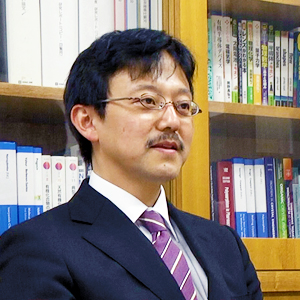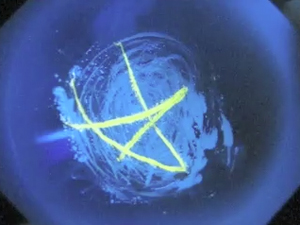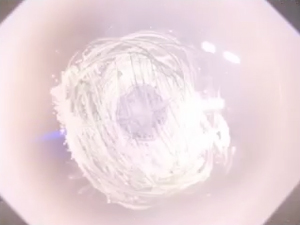Wow! Cool Laboratory [Researcher Introduction]

Division of Applied Chemistry,
Research Group of Industrial Organic Chemistry,
Laboratory of Organoelement Chemistry
Research fields: Organic chemistry, Coordination chemistry
Research themes: Luminescent mechanochromism, Development of synthetic reactions
E-mail: hajito[a]eng.hokudai.ac.jp
Luminescent mechanochromism: Mechanically induced molecular-level structure changes
A breakthrough in research on intermolecular interactions at the nanoscale level
Research Laboratory with an Aim to Create Novel Fields by Combining Organic Compounds and Various Elements
Research in modern chemistry targets all elements. This next-generation research lab under Professor Dr. Hajime Ito will conduct research in organoelement chemistry: A new research field for chemistry combining organic substances and various elements. On the basis of organic chemistry and organoelement chemistry, they are developing new catalytic reactions as well as new functional materials. The primary research themes in the lab are “luminescent mechanochromism,” “synthesis of organoboron compounds,” and “C–H bond activation.” Results from these projects are expected to find applications in fields such as medicine, liquid crystals, and organic EL materials.
In 2012, Ito and colleagues reported a method for the efficient synthesis of organoboron compounds from silylboranes, compounds containing a covalent Si–B bond. This novel method precludes the use of heavy metal-based catalysts in the synthesis of organoboron compounds, thereby, bringing about a 20-fold reduction in the cost of their synthesis. This method has facilitated the convenient and safe synthesis of several organoboron compounds. These organoboron compounds are essential reagents in Suzuki Coupling—a reaction discovered by Professor Emeritus Akira Suzuki—which make these compounds essential to organic synthesis.
Changes in Molecular Structure Induced by a Mechanical Stimulus can be Detected by Alterations in Luminescence
The report of a compound exhibiting luminescent mechanochromism—a phenomenon by which a solid structure changes its luminescent behavior when mechanically stimulated—was reported in 2008. Professor Ito says, “Change in the wavelength of light absorbed or emitted by a compound due to some form of an external stimulus is called chromism. It is widely accepted that stimuli such as heat, light, and electricity bring about a change in color of some compounds. Until recently, however, there were few reports that described a change in the luminescent behavior of a compound on mechanical stimulation, such as gently pressing or scratching. Such a discovery by our research group has prompted research efforts worldwide.”
In fact, the discovery of luminescent mechanochromism was serendipitous. The relevant gold-based metal complex, synthesized by a student in the course of a completely unrelated project (catalysis of an organic reaction), emits a pale blue light when exposed to UV light. The emission spectrum of the gold complex is measured by “sandwiching” the compound between two microscope quartz slides. On gently pressing the sample between the two microscope slides, the student noticed a dramatic change in the luminescence of the compound. Professor Ito, suspecting this to be a form of chromism, advised the student to investigate this phenomenon in greater detail.
Investigations through trial and error reveal that this phenomenon can be repeatedly triggered without any loss in luminescent intensity or degradation of the sample. On gently scratching the microscope slide covering the sample with a long, narrow tool such as a spatula, change in the luminescent behavior of the sample (blue luminescence shifts to yellow) only in the scratched area is observed. Addition of an organic solvent, such as dichloromethane, restores the original luminescence. This alteration in luminescence behavior can be successfully repeated at least 20 times (commentary 1: Video).
Professor Ito adds, “The greatest impact of this discovery is the realization that a mechanical stimulus caused by a tool few centimeters long can rearrange few molecules of a compound in the nanoscale range.” This point is best illustrated by imagining a working space equal to that of the Sapporo Dome (circumference of few kilometers) being used to rearrange sesame seeds (1 mm wide) on the ground. “Application of even a weak force alters the molecular structure of luminescent mechanochromic compounds. The changes in the structure of these compounds can be deduced from their luminescence spectra. Very few studies have investigated the mechanism by which a macroscale stimulus induces molecular-level changes in the structure of a molecule. Luminescent mechanochromism is an extremely sensitive phenomenon, wherein the slightest mechanically induced structural change is detected; therefore, this has potential applications in investigating the relationship between large physical forces and microscale molecules.”
Since then, over 200 luminescent mechanochromic molecules, synthesized in Professor Ito’s lab and other labs, have been reported. Initial results from Professor Ito’s lab suggest that luminescent mechanochromism is a result of subtle changes in the molecular arrangement (commentary 2). However, several aspects pertaining to macroscale (several centimeters) stimulus induced nanoscale (10,000-fold smaller) molecular changes remain unclear and are being clarified in Professor Ito’s lab.
World’s First Observation of Molecular “Domino Effect” in a Crystal
This lab also reported the world’s first molecular “dominoes cascade,” a phenomenon where an extremely small external stimulus induces a molecular-level transformation that propagates across an array of molecules.
“This phenomenon, wherein a small mechanical stimulus applied at a specific site in the crystal initiates a phase transformation at that site and is propagated throughout the crystal without affecting its external form and uniformity, is an extension of mechanochromism. Phase transitions in crystals induced by external stimuli such as heat, pressure, and light, have been widely recognized; however, we are the first in the world to observe a polymorphic transition triggered by a mechanical stimulus, i.e., gentle grinding or contact. We call this phenomenon molecular dominoes.” explains Professor Ito.
(Commentaries 1 and 3)
A single crystal of the synthesized novel mechanochromic organometallic compound (phenyl isocyanide) gold complex) contains ∼200 quadrillion (1015) molecules. When a molecule is considered as a domino, this phenomenon represents the world’s largest “dominoes”.
Investigating the Interaction Between Molecules
Potential applications in diverse fields
In the past 150 years, great progress has been made toward the synthesis of molecules and materials of different natures and sizes. It is now possible to synthesize materials of nanometer scale. Global research efforts are focused on developing efficient and cost-effective methods for the synthesis of these nanoscale materials. In biology, in addition to the independent roles of individual molecules in an organism, the relationship (or interactions) between molecules are also important. Several aspects of these interactions are intriguing. Again, in Professor Ito’s words, “I think our discoveries and observations can serve as a starting point for investigating the detailed workings of how molecules are arranged and how they interact. The study of molecular interactions and arrangements requires attention from a broad range of scientific disciplines; therefore, I do not think that understanding the mechanism of luminescent mechanochromism or molecular dominos will lead to a sudden expansion of knowledge. Nevertheless, just pinning down one specific aspect in the broad academic system can inspire innovative thinking in other researchers, potentially advancing the field in other directions.”
Professor Ito’s research spans several areas of basic science and may not be commercially viable in the near future. Be that as it may, insights gained from these studies will be valuable to several fields of study and can trigger unanticipated progress.
“The discoveries of luminescent mechanochromism and molecular dominoes have made it possible to measure weak forces that could not be measured by previous methods. For example, I think it will become possible to measure the kinds of forces that are responsible for cell division. In future, I wish to develop new luminescent mechanochromic probes and chips” says Professor Ito.
| Commentary 1 | Luminescent Mechanochromism (youtube) |
|---|---|
| Commentary 2 | Mechanism of Luminescent Mechanochromism (in Japanese) PDF from the AIST website |
| Commentary 3 | Molecular Domino effect (in Japanese) Press Release (2013/6/14) |


Fig. 1: New gold complex with the property of luminescent mechanochromism (exposed
to UV light)

Fig. 2: New gold complex with the property of luminescent mechanochromism (exposed
to ambient light)
